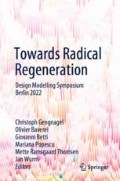Abstract
Research on mobile Augmented Reality (AR) technologies has proven many potentials and benefits for assisting craftspeople in various building applications within the AEC domain. However, little research has been done on the use of multi-user mobile AR systems coordinating several people at the same time. This paper examines the potentials of a collective construction process enabled by AR technology that distributes and guides manual assembly tasks for multi-user participation. For this purpose, a custom mobile AR app is developed that uses cloud services and allows multiple people to participate in the construction and be coordinated with each other at the same time. In the proposed setup, digital building instructions for the stepwise assembly of a physical building structure can be retrieved by multiple users via the app. The app positions these building instructions in 3D space, visually superimposed on the building site, where the building structure is being assembled. Methods are proposed for synchronizing the construction progress via user-specific AR content visualization over the app’s user interface (UI). Based on the principle of topologically interlocking structures, the material system developed for this research offers several form-fitting connections with one modular wooden component without the need for mechanical fasteners for their assembly. This principle enables the manual implementation of various complex building structures at full architectural scale, which are reconfigurable and fully disassemblable. The proposed methods were experimentally validated in a 1:1 scale demonstrator. A pavilion was assembled collectively by students and researchers over two days, and the UI was evaluated through a qualitative user study. As an outlook, the paper discusses the potential of such AR systems to make digitally-driven construction processes more tangible and accessible to laypersons and unskilled people and thus encourage community participation.
Access this chapter
Tax calculation will be finalised at checkout
Purchases are for personal use only
References
Rankohi, S., Waugh, L.: Review and analysis of augmented reality literature for construction industry. Visual. Eng. 1(1), 1–18 (2013). https://doi.org/10.1186/2213-7459-1-9
Chatzopoulos, Di., Bermejo, C., Huang, Z., Hui, P.: Mobile augmented reality survey: from where we are to where we go. IEEE Access 5, 6917–6950 (2017). https://doi.org/10.1109/ACCESS.2017.2698164
Billinghurst, M., Weghorst, S., Furness, T.: Shared space: an augmented reality approach for computer supported collaborative work. Virtual Real. 3(1), 25–36 (1998). https://doi.org/10.1007/BF01409795
Wagner, D., Pintaric, T., Ledermann, F., Schmalstieg, D.: Towards massively multi-user augmented reality on handheld devices. In: Gellersen, H.-W., Want, R., Schmidt, A. (eds.) Pervasive 2005. LNCS, vol. 3468, pp. 208–219. Springer, Heidelberg (2005). https://doi.org/10.1007/11428572_13
Reitmayr, G., Schmalstieg, D.: Mobile collaborative augmented reality. In: Proceedings of IEEE and ACM International Symposium on Augmented Reality, ISAR 2001, pp. 114–123 (2001). https://doi.org/10.1109/ISAR.2001.970521
Yoshida, H., et al.: Architecture-scale human-assisted additive manufacturing (2015)
Johns, R.L.: Augmented materiality: modelling with material indeterminancy. In: Fabricate, pp. 216–223 (2017)
Kyjanek, O., Al Bahar, B., Vasey, L., Wannemacher, B., Menges, A.: Implementation of an augmented reality AR workflow for human robot collaboration in timber prefabrication. In: Proceedings of the 36th International Symposium on Automation and Robotics in Construction (ISARC) (2019). https://doi.org/10.22260/isarc2019/0164
Jahn, G., Wit, A.J., Pazzi, J.: [BENT] Holographic handcraft in large-scale steam-bent timber structures. In: Ubiquity and Autonomy: Paper Proceedings of the 39th Annual Conference of the Association for Computer Aided Design in Architecture, ACADIA 2019, pp. 438–447, October 2019
Jahn, G.: Holographic Construction, December 2019
Sandy, T., Buchli, J.: Object-based visual-inertial tracking for additive fabrication. IEEE Robot. Autom. Lett. 3(3), 1370–1377 (2018). https://doi.org/10.1109/LRA.2018.2798700
Mitterberger, D., et al.: Augmented bricklaying. Constr. Robot. 4(3–4), 151–161 (2020). https://doi.org/10.1007/s41693-020-00035-8
Unity Real-Time Development Platform | 3D, 2D VR & AR Engine
Vuforia Library
Lharchi, A., Thomsen, M.R., Tamke, M.: Towards assembly information modeling (AIM). Simul. Ser. 51(8), 51–56 (2019)
Van Mele, T., et al.: Compas-dev/compas: COMPAS 1.14.1. Zenodo, Febraury 2022. https://doi.org/10.5281/zenodo.6108431
McNeel, R., et al.: Rhinoceros 3D, Version 7.0. Robert McNeel Assoc., Seattle (2022)
Pyrebase. https://github.com/thisbejim/Pyrebase
Parmentier, D.D., Van Acker, B.B., Detand, J., Saldien, J.: Design for assembly meaning: a framework for designers to design products that support operator cognition during the assembly process. Cogn. Technol. Work 22(3), 615–632 (2019). https://doi.org/10.1007/s10111-019-00588-x
Acknowledgements
This research was supported by the Technical University of Munich, School of Engineering and Design, Department of Architecture. We thank Design Factory for their expertise and support in prefabricating the timber modules. Wolfgang Wiedemann (Chair of Engineering Geodesy, TUM Department of Aerospace and Geodesy) conducted the measurements of the fiducial markers. Empfangshalle conceived and realized the wooden platform on which the pavilion was assembled. The authors would like to thank the students Zirui Huang and Andre Nikolai Berlin, who helped build the pavilion and participated in the survey. Additionally, we thank the students who participated in the design studio, “Participative Digital Fabrication”: Emmanuel Appiah Acheampong, Badr Ghammad, Veronica Giancola, Iuliia Larikova, Egzon Musa, Chiara Nespoli, Zhan Shi, Abdulhakeem Folorunsho Yusuff and Mohamed Elyes Zahrouni. The pavilion was realized as part of the program of the Kunstareal-Fest 2021 in Munich, Germany. Special thanks go to Laura Schieferle (Kunstareal München), who supported the project by providing the venue.
Author information
Authors and Affiliations
Corresponding author
Editor information
Editors and Affiliations
Rights and permissions
Copyright information
© 2023 The Author(s), under exclusive license to Springer Nature Switzerland AG
About this paper
Cite this paper
Atanasova, L. et al. (2023). Collective AR-Assisted Assembly of Interlocking Structures. In: Gengnagel, C., Baverel, O., Betti, G., Popescu, M., Thomsen, M.R., Wurm, J. (eds) Towards Radical Regeneration. DMS 2022. Springer, Cham. https://doi.org/10.1007/978-3-031-13249-0_15
Download citation
DOI: https://doi.org/10.1007/978-3-031-13249-0_15
Published:
Publisher Name: Springer, Cham
Print ISBN: 978-3-031-13248-3
Online ISBN: 978-3-031-13249-0
eBook Packages: EngineeringEngineering (R0)

